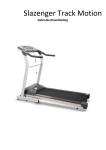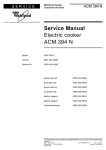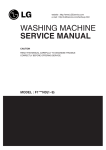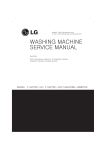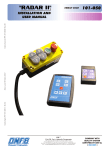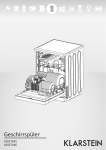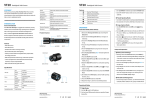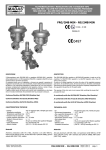Download OVEN
Transcript
DOMFP DOUBLE OVENS INSTALLATION and SERVICE INSTRUCTIONS USE and CARE INSTRUCTIONS distributed by PAREX Industries Ltd Dear Customer, Thank you for having purchased and given your preference to our product. The safety precautions and recommendations reported below are for your safety and that of others. They will also provide a means by which to make full use of the features offered by your appliance. Please preserve this booklet carefully. It may be useful in future, either to yourself or to others in the event that doubts should arise relating to its operation. This appliance must be used only for the task it has explicitly been designed for, that is for cooking foodstuffs. Any other form of usage is to be considered as inappropriate and therefore dangerous. The manufacturer declines all responsibility in the event of damage caused by improper, incorrect or illogical use of the appliance. FIRST USE OF THE OVEN It is advised to follow these instructions: < clean the interior of the oven with cloth soaked in water and detergent (neutral) then dry carefully; < furnish the interior of the oven by placing the wire racks as described at chapter “Use and care”; < insert shelves and tray; < swith on the empty oven on max to eliminate grease tracks from the heating elements. 2 IMPORTANT PRECAUTIONS AND RECOMMENDATIONS After having unpacked the appliance, check to ensure that it is not damaged. In case of doubt, do not use it and consult your supplier or a professionally qualified technician. Packling elements (i.e. plastic bags, polystyrene foam, nails, packing straps, etc.) should not be left around within easy reach of children, as these may cause serious injuries. , , , Do not attempt to modify the technical characteristics of the appliance as this may become dangerous to use. Do not carry out cleaning or maintenance operations on the appliance without having previously disconnected it from the electric power supply. If you should decide not to use this appliance any longer (or decide to substitute an older model), before disposing of it, it is recommended that it be made inoperative in an appropriate manner in accordance to health and environmental protection regulations, ensuring in particular that all potentially hazardous parts be made harmless, especially in relation to children who could play with unused appliances. WARNING: , , , , This appliance is to be installed only by an authorised person. This appliance must be used only for the task it has explicitly been designed for, that is for cooking foodstuffs. Any other form of usage is to be considered as inappropriate and therefore dangerous. Do NOT place combustible materials or products on this appliance at any time. The oven doors become very hot during operation. Keep children well out of reach. IMPORTANT PRECAUTIONS AND RECOMMENDATIONS FOR USE OF ELECTRICAL APPLIANCES Use of any electrical appliance implies the necessity to follow a series of fundamental rules. In particular: , , , , Never touch the appliance with wet hands or feet. Do not operate the appliance barefooted. The appliance is not intended for use by young children or infirm persons with supervision. Young children should be supervised to ensure they do not play with the appliance. The manufacturer cannot be held responsible for any damages caused by improper, incorrect or illogical use of the appliance. 3 INSTALLATION CAUTION: , In order to avoid a hazard this appliance must be installed according to these instructions for installation. ELECTRICAL REQUIREMENTS , , , , , , Connection to the mains must be carried out by qualified personnel in accordance with current regulations. The appliance must be connected to the mains, checking that the voltage corresponds to the value given in the rating plate and that the electrical cable sections can withstand the load specified on the plate. The appliance must be connected directly to the mains placing a two pole switch with minimum opening between the contacts of 3 mm between the appliance and the mains. The power supply cable must not touch the hot parts and must be positioned so that it does not exceed 75°C at any point. Once the appliance has been installed, the switch or socket must always be accessible. If the supply cord is damaged it must be replaced by the manufacturer or it’s Service Agent or a similarly qualified person in order to avoid a hazard. WARNING: THIS APPLIANCE MUST BE EARTHED. THIS OVEN MUST BE CONNECTED TO SUPPLY USING V105 INSULATED CABLE. ELECTRIC DIAGRAM KEY S2 S1 1a 2a 3a 1 2 3 4a 4 5a 5 6a 7a 6 7 8a 8 9a 9 10a 10 11a 11 E2 5 P3 1 1a 2 P1 N/7 1 L/8 3 P2 TOP OVEN PR F2 F1 E1 4 LF2 F2 E2 S2 LF2 C1 G1 S1 TL1 Oven switch Oven thermostat Thermostat pilot lamp Oven lamp Top element Grill element Bottom element Oven thermolimitator MAIN OVEN F1 E1 S1 PR LF C G V S CIR TL2 C1 LF G1 S1 C TL1 CIR G TL TL3 CF V S CF Cooling fan TL3 Thermolimitator TL TL2 T M 4 L N Oven switch Oven thermostat Thermostat pilot lamp Oven programmer 1P Oven lamp Top element Grill element Fan Bottom element Circular element Oven thermolimitator 1131125 1131185 M T Terminal block Earth plant CONNECTING THE FEEDER CABLE < Remove the two screws that hold shield A behind the oven. < Open the cable clamp C completely. < Insert the feeder cable (Type V105) of minimum 2.5 mm2 cross section through the cable gland P. < Connect the phase, neutral and earth conductors to terminal B according to Fig. 1. The wires of this appliance must be coloured in accordance with the following code: GREEN AND YELLOW - EARTH BLUE - NEUTRAL BROWN - LIVE The wire which is coloured GREEN AND YELLOW must be connected to terminal in the plug which is marked with the letter “E” or by the Earth W symbol or coloured GREEN or GREEN AND YELLOW. The wire which is coloured BLUE must be connected to the terminal which is marked with the letter “N” or coloured BLACK. The wire which is coloured BROWN must be connected to the terminal which is marked with the letter “L” or coloured RED. < Pull the feeder cable and secure it with cable clamp C. < Re-mount shield A. REPLACING THE POWER SUPPLY CABLE Use the same type of power supply cable. Figure 1 B Green & Yellow (earth) Brown (live) A C P Blue (neutral) 5 FITTING REQUIREMENTS The appliance must be built-in in a standard module of 60 cm width and depth. It is to be fit in a module having the clearance as shown in the pictures. On the lower side, the oven must lay on supports standing the oven weight. The ovens are secured by four screws that pass through the surround. They must locate firmly and squarely in the edges of the cabinet or add panels to achieve a secure location. < Some appliances are supplied with a protective film on steel and aluminium parts. This film must be removed before using the appliance. Figure 2 50 888 0 400 40 900 600 555 0 57 59 4 6 0 54 20 m in FITTING THE OVEN The cabinet should have the clearances as per Fig.2 and should have lateral supports to allow for good air circulation for cooling. A chimney is required as shown in Fig.2 and 3. If the unit reaches the ceiling of the kitchen, then an external air outlet must be provided. Dimensions H W D Flush 900 600 570 Trim exposed 877 560 550 N.B. Drawings throughout this brochure have “Integrated Flush” dimensions. Installation Method Figure 3 50 mm 50 550 7 USE and CARE CAUTION: , , This appliance must be used only for the task it has explicitly been designed for, that is for cooking foodstuffs. Any other form of usage is to be considered as inappropriate and therefore dangerous. Do NOT place combustible materials or products on this appliance at any time. USING THE TOP AND THE MAIN OVEN FOR THE FIRST TIME You are advised to carry out the following operations: , , , Clean the inside of the oven with a cloth soaked in water and neutral datergent and dry thoroughly. Slide in the catalytic liners and wire racks on the oven walls as shown in Fig. 4a and 4b. Slide in, on the guides, the shelf and the tray etc. (Figure 5). Figure 4a TOP OVEN , To eliminate traces of grease from the heating elements, switch the ovens on to the maximum temperature as follows: B top the oven: for 60 minutes in position, and for another 15 minutes in the position; B bottom oven: for 60 minutes in the position, for 30 minutes in the position and for another 15 minutes in the position. Figure 4b MAIN OVEN A 8 Figure 5 TOP OVEN GENERAL FEATURES This is a conventional oven with 2 cooking positions and 3 heating elements (top, bottom and grill), thermostatically controlled. TOP OVEN OPERATING PRINCIPLES Heating and cooking in the CONVENTIONAL oven are obtained in two following ways: < by normal convection The heat is produced by the upper and lower heating elements. < by radiation The heat is radiated by the infra red grill element MAIN OVEN GENERAL FEATURES This is a MULTI-FUNCTION oven. As its name indicates, this is an oven that presents particular features from an operational point of view. In fact, it is possible to utilize 7 different programs to satisfy every cooking need. The 7 positions, thermostatically controlled, are obtained by 4 heating elements (top, bottom, grill and circular). MAIN OVEN OPERATING PRINCIPLES Heating and cooking in the MULTI-FUNCTION oven are obtained in the following ways: < by normal convection The heat is produced by the upper and lower heating elements. < by forced convection The fan draws in air contained within the oven housing at the rear of the oven and forces it over the circular heating element. The hot air envelops the food in the oven giving faster and more even cooking before it is drawn back into the housing to repeat the cycle. It is possible to cook several dishes simultaneously. < by semi-forced convection The heat produced by the upper and lower heating elements is distributed throughout the oven by the fan. < by radiation The heat is radiated by the infra red grill element. < by radiation and ventilation The radiated heat from the infra red grill element is distributed throughout the oven by the fan. 9 CONTROL PANEL 6 6 Stainless steel model TOP OVEN MAIN OVEN Function Temperature 0 Function Temperature 0 50 50 75 75 100 250 225 125 225 150 200 100 250 125 200 175 175 150 Figure 6 1 3 2 5 4 6 6 White model TOP OVEN MAIN OVEN Function 16 : 00 Temperature Function Temperature 0 0 50 50 75 75 100 250 125 225 125 225 150 200 100 250 200 175 175 Figure 7 1 2 3 CONTROLS DESCRIPTION 1. Digital electronic programmer (Main oven only) 2. Function selector (Top oven) 3. Thermostat (Top oven) 4. Function selector (Main oven) 5. Thermostat (Main oven) 6. Temperature light 10 4 5 150 TOP OVEN TOP OVEN Function Temperature 0 50 75 100 250 125 225 150 200 175 Figure 8 FUNCTION SELECTOR KNOB THERMOSTAT KNOB Rotate the knob clockwise to set the oven for one of the following functions. This only sets the cooking temperature and does not switch the oven on. Rotate clockwise until the required temperature is reached (from 50 to 250°C). OVEN LIGHT By setting the knob to this position, only the oven light will come on. The oven light will stay on when any of the cooking functions are selected. TRADITIONAL CONVECTION COOKING The upper and lower heating elements come on. The heat is dispersed by natural convection and the temperature must be set to between 50° and 250° C via the thermostat knob. The oven must be preheated before cooking. Recommended for: Food that requires the same degree of cooking both inside and out, for example roasts, spare pork ribs, meringues etc. 11 GRILLING The infrared element comes on. The heat is dispersed by radiation. Use with the thermostat knob set to 200°C max and the oven door closed. For cooking hints, see the chapter “USE OF THE GRILL”. Recommended for: Intense grilling, browning, cooking au gratin and toasting, etc. It is recommended that you do not grill for longer than 30 minutes at any one time. Caution: The oven door becomes very hot during operation. Keep children well out of reach. COOKING IN A CONVENTIONAL TOP OVEN , , , , The oven has two heating elements, one on the base and one on the roof of the cavity. Hot air rises, so the top of the oven is always the hottest. The temperature in the middle of the oven is maintained at the temperature set by the control knob, and is slightly hotter above and cooler below. In a conventional oven, dishes requiring different temperatures can be cooked in the oven at the same time - e.g. roast beef and Yorkshire pudding. Always pre-heat the conventional oven before use. The oven indicator light will go out when the required temperature is reached. Do not open the oven door during cooking unless absolutely necessary. IMPORTANT: Drip trays, baking trays etc. must not be left on the base of the oven as this could damage the appliance. USE OF THE GRILL Switch the grill on by setting the selector knob to and the thermostat knob to position 200°C max. Leave to warm up for approximately 5 minutes with the door closed. Place the food inside positioning the rack as near as possible to the grill. Insert the drip pan under the rack to collect the cooking juices. It is recommended that you do not grill for longer than 30 minutes at any one time. Always grill with the oven door closed. Remember to keep children away from the appliance when you use the grill or oven , since these parts become very hot. 12 MAIN OVEN MAIN OVEN Function Temperature 0 50 75 100 250 125 225 200 175 150 Figure 9 FUNCTION SELECTOR KNOB THERMOSTAT KNOB Rotate the knob clockwise to set the oven for one of the following functions. This only sets the cooking temperature and does not switch the oven on. Rotate clockwise until the required temperature is reached (from 50 to 250°C). OVEN LIGHT By setting the knob to this position, only the oven light will come on. The oven light will stay on when any of the cooking functions are selected. TRADITIONAL CONVECTION COOKING The upper and lower heating elements come on. The heat is dispersed by natural convection and the temperature must be set to between 50° and 250° C via the thermostat knob. The oven must be preheated before cooking. Recommended for: Food that requires the same degree of cooking both inside and out, for example roasts, spare pork ribs, meringues etc. 13 GRILLING The infrared electrical element comes on. The heat is dispersed by radiation. Use with the thermostat knob set to 200°C max and the oven door closed. For cooking hints, see the chapter “USE OF THE GRILL”. Recommended for: Intense grilling, browning, cooking au gratin and toasting, etc. It is recommended that you do not grill for longer than 30 minutes at any one time. Caution: The oven door becomes very hot during operation. Keep children well out of reach. DEFROSTING FROZEN FOODS • Only the oven fan comes on. Use with the thermostat knob set to “ ” - other positions have no effect. The food is thawed by ventilation without heating. Recommended for: Quick thawing of frozen foods; one kg requires approximately 1 hour. Thawing times vary according to the quantity and type of food to be thawed. HOT AIR COOKING The circular element and fan come on. The heat is dispersed by forced convection and the temperature can be regulated to between 50° and 250°C via the thermostat knob. The oven does not require preheating. Recommended use for: Food which has to be well-cooked outside and soft or rosy inside, for example lasagne, lamb, roast beef, whole fish etc. 14 VENTILATED GRILL COOKING The infrared grilling element and the fan come on. The heat is diffused mainly by radiation and the fan then distributes it throughout the oven. Use with the door closed. The temperature can be regulated via the thermostat knob to between 50 and 175°C max. The oven must be preheated for approximately 5 minutes. For cooking hints, see the chapter “GRILLING AND AU GRATIN”. Recommended for: Grilling where quick browning on the outside is required to keep the juices in. For example: veal fillets, chops, hamburgers etc. It is recommended that you do not grill for longer than 30 minutes at any one time. Caution: The oven door becomes very hot during operation. Keep children well out of reach. MAINTAINING TEMPERATURE AFTER COOKING OR SLOWLY HEATING FOODS The upper element, the circular resistance and the fan come on. The heat is dispersed by forced convection with great intensity in the upper part. The temperature can be set to between 50° and 150° via the thermostat knob. Recommended for: Keeping food warm after any type of cooking. Slow heating of cooked food. CONVECTION COOKING WITH VENTILATION The upper and lower heating elements come on and heat is dispersed through the oven by the fan. The temperature must be set between 50° and 250° C via the thermostat knob. Recommended for: Voluminous dishes and large quantities which require the same degree of cooking both inside and out, for example rolled roasts, turkey, roast legs, cakes etc. 15 MAIN OVEN COOKING ADVICE STERILIZATION Sterilisation of foods to be conserved, in full and hermetically sealed jars, is done in the following way: , , , , Set the switch to position . Set the thermostat knob to 185° C and preheat the oven. Fill the drip pan with hot water. Set the jars onto the dripping pan making sure they do not touch each other and the door and set the thermostat knob to 135° C. Once the sterilization process has begun, i.e. when you begin to see bubbles in the jars, switch the oven off and leave to cool. REGENERATION Set the switch to position and the thermostat knob to position 150°C. Bread becomes fragrant again if wet with a few drops of water and put into the oven for about 10 minutes at the highest temperature. SIMULTANEOUS COOKING OF DIFFERENT FOODS The main oven set on position allows a simultaneous heterogeneous cooking of different foods. Different foods such as fish, cake and meat can be cooked together without mixing the smells and flavors together. This is possible since the fats and vapours are oxidized while passing through the electrical element and therefore are not deposited onto the foods. The only precautions to follow are: The cooking temperatures must be as close as possibile with a maximum difference of 20°÷25° C between the different foods. Different dishes must be placed in the oven at different times according to the cooking time required for each one. , , This type of cooking provides a considerable saving on time and energy. 16 USE OF THE GRILL Switch the grill on by setting the selector knob to position and the thermostat knob to position 200°C max. Leave to warm up for approximately 5 minutes with the door closed. Place the food inside positioning the rack as near as possible to the grill. Insert the drip pan under the rack to collect the cooking juices. It is recommended that you do not grill for longer than 30 minutes at any one time. Always grill with the oven door closed. Remember to keep children away from the appliance when you use the grill or oven , since these parts become very hot. GRILLING AND COOKING “AU GRATIN” As the hot air completely covers the food to be cooked, grilling may be done with the food on rack in the oven. The knob should be switched to position . The thermostat should be set to 175°C and the oven pre-heated. The food should be placed on a rack in the oven for the required cooking time. Adding a few dabs of butter before the end of the cooking time gives the golden “au gratin” effect. It is recommended that you do not grill for longer than 30 minutes at any one time. Always grill with the oven door closed. Caution: The oven door becomes very hot during operation. Keep children well out of reach. ROASTING To obtain the classic “roast”, it is advisable to maintain a temperature between 180-200°C, and the length of cooking time depends on the thickness of meat to be cooked and the type of meat. 17 ELECTRONIC PROGRAMMER (main oven only) The electronic programmer is a device that groups together the following functions: ò 24 hour clock with illuminated display ò Timer (up to 23 hours and 59 minutes) ò Program for automatic oven cooking ò Program for semi-automatic oven cooking. Description of the buttons: Timer Cooking time End of cooking time Manual cooking or cancellation of cooking programs Plus function to increase the number shown on the display Minus function to decrease the number shown on display or to change the buzzer frequency Description of the illuminated symbols: AUTO - flashing - Programmer in automatic position but not programmed. AUTO - always illuminated - Programmer in automatic position with program set Automatic cooking taking place Timer in operation and AUTO - flashing - Program error. (The time of day lies between the calculated cooking start and end time). Note: Select a function by the rispective button and, in 5 seconds, set the required time with the / buttons (“one-hand” operation). A power cut zeroes the clock and cancels the set programs. Figure 10 18 Figure 11 ELECTRONIC CLOCK The illuminated figures on the clock represent hours and minutes on a 24 hour clock. When first connected, or after a power failure, three zeros will flash on the display. To set the time press the button and then the or . Please note that changing the hour button deletes any cooking program. NORMAL COOKING WITHOUT THE USE OF THE PROGRAMMER To manually use the oven, that is, without the aid of the programmer, it is necessary to cancel the flashing AUTO by pushing the button (AUTO will be switched off and symbol will go on). Attention: If the AUTO is not flashing (which means a cooking program has already been inserted), by pushing the button you have cancelled the program and switched to manual. ELECTRONIC TIMER The timer program consists only of a buzzer which may be set for a maximun period of 23 hours and 59 minutes. If the AUTO is flashing push the button. To set the timer, push the button and the or until you obtain the desired time. Having finished the setting, the normal time will appear on the panel and the symbol will appear. The countdown will start immediately and may be checked at any time by pressing the button . At the end of the time, the symbol will be switched off and an intermittent buzzer will sound: this can be stopped by pressing any one of the buttons. SETTING THE FREQUENCY OF THE AUDIBLE SIGNAL By pressing the button you can choose from three variations. Figure 12 Figure 13 19 AUTOMATIC OVEN COOKING To cook food automatically in the oven, it is necessary to: <Set the length of the cooking time <Set the end of the cooking time <Set the temperature and the oven cooking program. These operations are performed as follows: <Set the length of the cooking time by pushing the button and the button to advance, or to go back if you have passed the desired time. The AUTO and the symbol will be on. <Set the end of the cooking time by pressing the button (the cooking time already added to the clock time will appear), and the button; if you pass the desired time you may get back by pushing the button. After this setting, the symbol will sound. If after this setting, the AUTO flashes on the panel and buzzer goes off, it means there was an error in the programming.In this case, modify the end of cooking time or the cooking time itself by following the above instructions again. <Set the temperature and the cooking program by using the switch and thermostat knobs of the oven (see specific chapters). The oven is now set to turn on and off at the programmed times. During cooking the symbol remains on. By pushing the button you can see the time that remains until the end of cooking. The cooking program may be cancelled in any time by pushing . At the end of the cooking time the oven will turn off automatically, the symbol will turn off, AUTO will flash and the buzzer will sound, which can be turned off by pushing any of the buttons. Turn the temperature and thermostat knobs to zero and set the programmer to “manual” by pressing the button. Attention: A power cut makes the clock go to zero and cancels the set programs. After a power cut three zeroes will flash on the panel. Figure 14 20 Figure 15 SEMI - AUTOMATIC COOKING This is used to automatically switch off the oven after the desired cooking time has elapsed. There are two ways to set your oven: <Set the length of the cooking time by pushing the the button to advance, or desired time. button and to go backwards if you have passed the or <Set the end of the cooking time by pushing the button and the button to advance, or to go backwards if you have passed the desired time. AUTO and the symbol will be on. Then set the temperature and the cooking program using the oven switch and thermostat knobs (see specific chapters). The oven is switched on and it will be switched off automatically at the end of the desired time. During cooking, the symbol remains on and by pressing the button you can see the time that remains till the end of the cooking. The cooking program can be cancelled at any moment by pushing the button. At the end of cooking, the oven and the symbol will turn off, the AUTO will flash and a buzzer will sound; that can be stopped by pushing any of the buttons. Turn the temperature and thermostat knobs to zero and set the programmer to “manual” by pressing the button. Figure 16 Figure 17 21 CLEANING and MAINTENANCE GENERAL ADVICE < Before you begin cleaning, you must ensure that the appliance is switched off. < It is advisable to clean when the appliance is cold and especially for cleaning the enamelled parts. < Avoid leaving alkaline or acid substances (lemon juice, vinegar, etc.) on the surfaces. < Avoid using cleaning products with a chlorine or acid base. < The ovens must be always cleaned after every use, using suitable products and keeping in mind that its operation for 30 minutes on the highest temperature eliminates most grime reducing it to ashes. < Do not use a steam cleaner because the moisture can get into the appliance thus make it unsafe. ENAMELLED PARTS All of the enamelled parts must be washed only with a sponge and soapy water or with non-abrasive products. Dry, preferably, with deer skin. STAINLESS STEEL CAUTION: The stainless steel surfaces used in this appliance are protected with a Special Lacquer to reduce finger-print marks. To avoid damaging this lacquer, do not clean the stainless steel with abrasive cleaners or abrasive cloths or scouring pads. ONLY SOAP/WARM WATER MUST BE USED TO CLEAN THE STAINLESS STEEL SURFACES. GRILL HEATING ELEMENT The heating element is self-cleaning and does not require maintenance. SUBSTITUTION OF THE OVEN LIGHT Be sure to switch off the electrical supply. The light bulb must be a type resistant to high temperatures (300°C). Before any cleaning or maintenance operation, disconnect the appliance from mains power supply. 22 ADVICE FOR USE AND MAINTENANCE OF CATALYTIC PANELS (main oven only) The catalytic panels are covered with special microporous enamel which absorbs and does away with oil and fat splashes during normal baking over 200°C. If, after cooking very fatty foods, the panels remain dirty, operate the oven “idling” on max temperature for about 30 minutes. These panels do not need to be cleaned, however it is ad vised to periodically remove them from the oven (at least the side panels) and to wash them with tepid soapy water and then wipe off with a soft cloth. Do not wash or clean with abrasive products or with products containing acids or alkalis. The side panels are reversible and when the catalytic microporous enamel degrades, they can be turned to the other side. GREASE FILTER (main oven only) A special screen is provided at the back of the oven to catch grease particles, mainly when meat is being roasted (fig. 18). When baking pastry etc. this filter should be removed. Always clean the filter after cooking as any solid residues on it might adversely affect the oven performance. The grease filter can be removed for cleaning and should be washed regularly in hot soapy water. Always dry the filter properly before fitting it back into the oven. Figure 18 23 OVEN DOORS The internal glasses of the oven doors can be easily removed for cleaning by unscrewing the two fixing screws (figure 19). TROUBLESHOOTING: If you should have a problem with your oven, check the following points before calling our customer service centre. 1. The power is switched on. 2. The controls are switched on. 3. The electronic timer is set to manual. 4. Both the fuse and the mains fuse are intact. Figure 19 24 25 26 27 Code 1101893 - b2 Descriptions and illustrations in this booklet are given as simply indicative. The manufacturer reserves the right, considering the characteristics of the models described here, at any time and without notice, to make eventual necessary modifications for their construction or for commercial needs. distributed by PAREX Industries Ltd





























